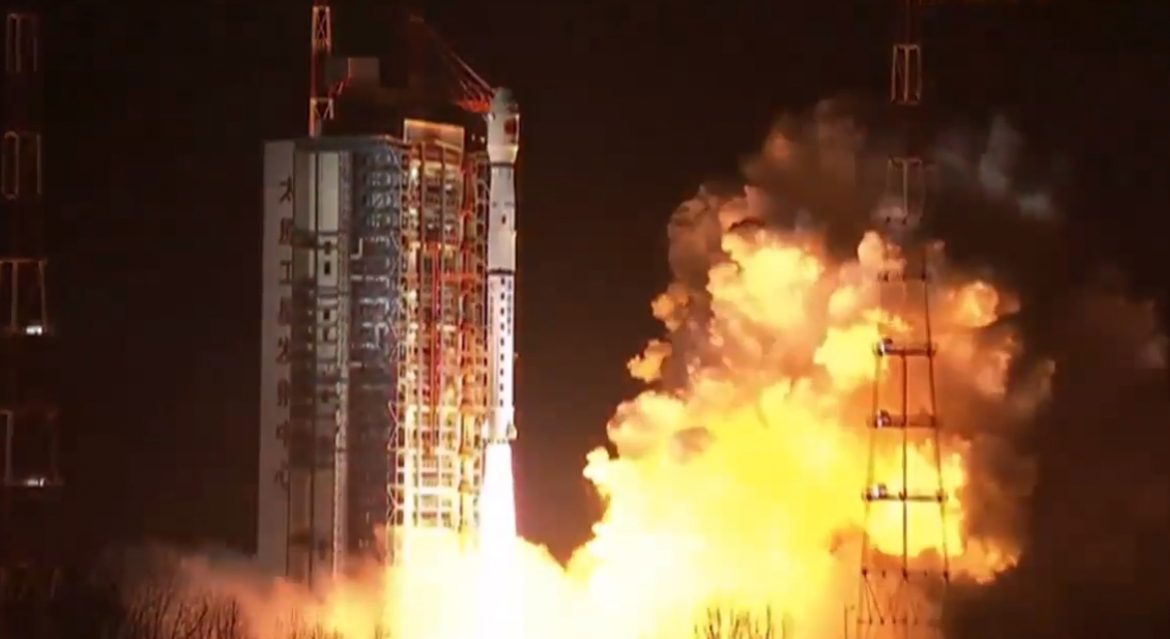 The moment of launch. Nasaspaceflight source
The moment of launch. Nasaspaceflight sourceChinese scientists, as promised, continue to actively move in the direction of the moon. In other words, they are developing vehicles designed for the development of the Earth’s satellite. Today
it became known about the successful launch of the Queqiao spacecraft - this is a communications satellite that will be used to establish the connection of the Earth to the Chang'e-4 station. The launch was made using a Long March 4C booster. Actually, the Chinese have all their own - rockets, satellites, launch pads, and so on.
Previous launches under one big moon exploration program included sending Chang'e-1 into space in 2007, Chang'e-2 in 2010. This was followed by the dispatch of Chang'e-3 and Yutu moon rover. Surprisingly, all systems worked well. This year, Chang'e-4 will be sent to the moon, a mission that includes two elements - a landing platform and a rover.
Chinese scientists have already determined the place of landing on the moon - it will be the crater Von Karman, which is located on the back of the moon. If all goes well, the new device will be the first human-made system to sit in this region. Well, since the location is not very convenient for the implementation of direct radio communication, the mission also needs a specialized satellite that can receive and transmit signals.
The mass of the spacecraft is 425 kilograms. It is equipped with transmitters of S-band and X-band. After reaching the calculated position, the satellite should be at the Lagrange point L2 in the Earth-Moon system. This point is located at a distance of about 455 thousand km from our planet. During the year, the Chinese plan to test the satellite.
Chang'e-4 will also perform a scientific mission. So, one of his tools is scientific. This is an antenna made by Dutch scientists, which will pick up waves with a frequency below 30 MHz. The fact is that on Earth these waves are absorbed by the atmosphere, and they are very important for science, since they allow us to study the early stages of the evolution of the Universe. In addition, the satellite toolkit will also include a Chinese laser corner reflector, which is necessary for measuring the distance between the device itself and the ground station.
As for launch vehicles, China sooner or later
hopes to create its own reusable carrier with a returnable first stage. True, before the advent of the working sample, which can be tested, for a long time - the first launch will take place no earlier than 2020. This truck will be able to output a payload of up to 4.5 tons into an orbit of 700 kilometers in height. Most likely, the rocket will be used by China itself, as well as by private companies from around the world who can charter a truck for their own needs.
Among the long-term goals of China and the exploration of the Moon with the extraction of
helium-3 , and the sending of probes into deep space, and the creation of
its own rover . In addition, China Aerospace Science and Technology Corporation (CASC) plans to create its own nuclear-powered shuttle. True, not now, but only by 2040. According to scientists from China, nuclear-powered rockets can be used for any purpose, including mastering the asteroid belt, visiting the stars, and flying to other planets in the solar system.
And China, together with ESA, are discussing the possibility of creating a lunar base. “The Chinese have a very ambitious moon exploration program,” said Pal Hwistendal, ESA spokesman. “The space industry has changed since the 60s race. We recognize that international cooperation is needed to explore space for peaceful purposes. ” According to the partners, the lunar base
can be used as a launching pad for the exploration of Mars, the foundation of a tourist space agency, or even for launching the development of the bowels of a natural Earth satellite.
Perhaps China wants to get ahead of the United States in this regard, which again looks at the Moon as the optimal platform for creating a colony of people there - at least in order to be able to go to other planets. Fuel, apparently, can be mined precisely on the moon, although, of course, this requires a deployed industrial infrastructure.
In addition to the state, private companies also took up the study and conquest of space in China. One of these days on Geektimes
it was reported about a startup OneSpace, which launched the first private rocket in China. Start was made this week. This is a small suborbital rocket, whose height is about 9 meters. So far, this rocket is only a proof-of-concept, it has provided an opportunity to confirm the possibility of the launch itself and obtain the necessary information about the flight itself.